Update: My Full In-Depth Review for both the Withings Body and Body Cardio scales can be found here!
Today Withings released their WiFi scale, the Withings Body Cardio along with the new Withings Body scale (sans-Cardio). Like all past Withings scales, these units connects via WiFi to your home network (after Bluetooth Smart configuration with your phone). However, it kicks things up a notch in the data stats department by adding in a number of additional metrics beyond just weight and body fat. These new metrics being: water mass, bone mass, and the mysterious sounding Pulse Wave Velocity on the Body Cardio scale.
This is all in addition to the existing standing heart rate value they’ve had on their higher end scales before (kept on the Body Cardio, but not base Body scale). However, in addition to these new features, they also removed a couple of things: room temperature and CO2 measurement. Apparently the company agreed with folks that these had practically no real-world value.
Plus, there’s some cool tricks up the scale’s sleeve when it comes to floor surfaces.
I’ve got a unit here that I picked up at the Withings HQ yesterday, so it’s only been on my floor a rather brief time period. So I’ll do a full in-depth review sometime later this summer (I will need more time, as pulse wave velocity really requires a long timeframe), but in the meantime this post serves as a bit of a placeholder.
Let’s dive into things!
Getting Started:
I think the Body Cardio scale might be the thinnest scale box out there. It’s surprisingly small.
One reason it’s likely so small is that it lacks having to package a bunch of feet with it. That may sound trivial, but most feet are about half the height of a scale, so basically you’re significantly increasing your scale packaging. Aside from a brief quick-start guide, the only other thing in the box is the micro-USB cable.
Now why does the lack of scale feet matter? Well most scales need additional plastic feet on them if you’re using them on carpet (even Withings’ past WiFi scales). Whereas the new Body Cardio doesn’t need such feet. It’s bi-flooring. It can go back and forth between hardwood and carpet flooring.
You’ll notice that the scale doesn’t have a battery compartment for AAA or AA batteries, likely further shrinking the depth of it. In this case it uses a rechargeable battery. The company says you can charge it once per year, just using the simple included standard micro-USB cable:
Once you’ve selected a final resting place for your scale you’ll go ahead and get it all setup. The process only takes a minute or two using your smartphone. The phone will pair via Bluetooth Smart first, and then it’ll configure the WiFi settings on your scale.
Following the smartphone configuration, everything then happens via WiFi on a day to day basis. So as you step on the scale it’ll connect to the Withings backend service via WiFi and then pull down user information. You can have up to 8 people use the same scale, and it’ll allow you to select which person you are (if it doesn’t figure it out automatically). That enables the scale to not only track individual metrics, but also gives you correct data around things such as BMI, which requires height.
New Metrics & Pulse Wave Velocity:
So let’s talk about what’s happening here after you step on the scale. First screen will be your weight, just like it would have been on past scales.
Within a few seconds it’ll show you your weight, and then ask for your name. It does this so it can determine body fat.
Following that you can get your standing heart rate. Now I’ve repeatedly noted that I think this is a hugely worthless metric, because the variability in measuring standing HR can be swayed 10-30bpm simply in a few seconds depending on what you were doing just before stepping onto the scale. Were you walking from the bed? In the shower? Taking a dump? All of which can and will impact standing HR to the point that any trending on that data is a mess.
Next, it’ll go ahead and display additional body composition metrics: Bone mass, muscle percentage and water percentage. It’ll show all of these immediately.
In the box you’ll also get any trends that you have:
Finally, you’ll get the weather forecast for that current day, along with the steps you had for yesterday. Steps will be shown for Withings step counter devices (like the Withings Activité activity tracker). Though Withings is cool in that if you forget your Activité tracker you can ask it to populate the step data using your phone’s internal step tracking data.
The weather data, Withings argues, is there because they’ve found that when people make a pattern out of something (such as stepping on the scale in the morning), they’re more likely to do it again. By giving you the weather for the day, the logic is that you’ll step on the scale to get the weather to decide which clothing you’d wear that day. To be fair, that logic is pretty….logical.
For whatever reason, the backend service seems to be a bit slow this morning for weather/steps, so I can’t quite show a photo of that yet.
So what about pulse wave velocity?
Well, it’s kinda complex. But at a high level, it’s “the speed of the wave generated by your heartbeat along your arteries”. Here’s an image that Withings put together:
Withings will take about 15 seconds to measure this value, as it’s timing how long it takes for the blood being ejected by the aorta to reach the vessels in the feet. The slower this happens, the healthier you’re getting. In theory anyway. Note that traditionally measuring this takes at least 20 minutes with a bunch of medical gear. So it remains unclear at this point how accurate the measurement really is, beyond the study Withings did with 111 people. Also, Withings isn’t calling it a medical measurement.
Once the scale measures this, it plots it onto graphs that you can see within the app. Thus allowing you to trend more easily.
So is this metric actually meaningful? Well, that’s tough. Most times companies toss in fancy metrics, it’s little more than marketing jazz. Companies in the space do this all the time. The majority of the time there’s absolutely no studies behind it, it’s just thrown out there like someone throwing out ideas for lunch.
However, sometimes companies go one step further. They find some study on a topic somewhere, and decide to try and back their product based on a semi-related study. Then sometimes companies go even further, and they will actually undertake a study of their own (funded by them) to prove their point.
That’s what Withings has done. They had a medical team at a nearby hospital measure 111 people comparing the pulse wave results from the Withings Body Cardio scale to that of a traditional sphygmomanometer. That produces the below chart (to the right), which Withings describes as “good correlation”.
On one hand, one has to remember that Withings paid for this study and controlled whether or not the results were released. They also haven’t released the full data from the study to allow more concrete analysis.
Yet on the other hand, they’ve already backed up their claims with a heck of a lot more data than most consumer sports/technology fitness companies do. At least they made an attempt at it. Hopefully some university or other medical facility decides to do a study on their own, without Withings funding, to see if the data can be corroborated.
I’ve uploaded the intro PDF here, and the slightly more detailed pulse wave velocity PDF here. Both are obviously provided by Withings. Note there are a slew of medical study references at the end of the second PDF.
Now one exceptionally odd thing is that the new Pulse Wave Velocity metric isn’t actually shown on the scale, but only on the app afterwards. I can see how it might need to pull data from the backend service to make a determination, but since it does that for steps anyway – it would seem like it could wait a few seconds and then show you that data. After all, that’s why you buy the scale. Odd.
Also, it takes about 5 measurements worth of Pulse Wave Velocity before you start getting any trends. Thus with only having the unit for 24 hours, it’s too soon for that for me. Check back in a week or so and I’ll let ya know.
Finally – note again that the Body Cardio has Pulse Wave Velocity and standing HR, but not the new Body scale (that’s the cheaper one at $129).
Wrap-up:
So is it worth the $179 for the Body Cardio scale? Well, it’s probably a bit too soon to know. In general though, you’ll remember I’m not a huge fan of additional scale metrics beyond just simple weight. I think most people will get what they need from weight, and that metrics like body fat and others are far too easily influenced by other day to day factors (like going to the bathroom or a workout). You can typically get them semi-consistent if you take them at the same time each day, but as I’ve shown previously, they don’t tend to be super accurate.
However, the real strength of the Withings WiFi scales is their platform. Or rather, their connectivity to 3rd parties. They’re incredibly open when it comes to getting that data to other partners (i.e. MyFitnessPal), more so than any other company. In many ways, the Body Cardio scale is a shot across Garmin’s bow and their Index Scale, since both are high-end body composition scales featuring very similar metrics. And at $129, the new Body (non-Cardio) essentially has all the same features as the Garmin Index scale that sits at $149. It just lacks the Pulse and HR action of the Body Cardio.
So, if you can’t decide yet – check out my post from this winter on choosing a WiFi connected scale. It might give you some insight into the market, as well as what features and functions really matter. I’ll be adding in the Body Cardio scale shortly, so you can also compare that soon in the product comparison tool.
With that – thanks for reading, and stay tuned for more!
–
Update: You can now order the Withings Body (that’s the $129 variant) from Clever Training. Plus, you can use DCR Coupon Code DCR10BTF to save 10% and also get free US shipping. All of which supports the site here. Meanwhile, the higher end Withings Body Cardio scale will be available on July 1st via Clever Training. Thanks!


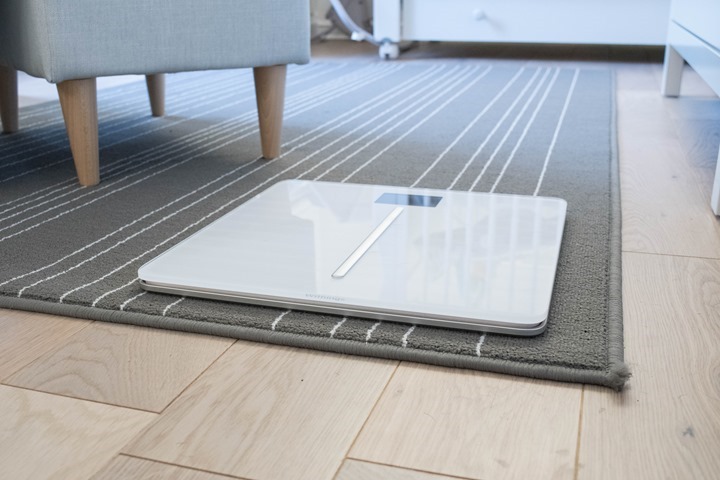
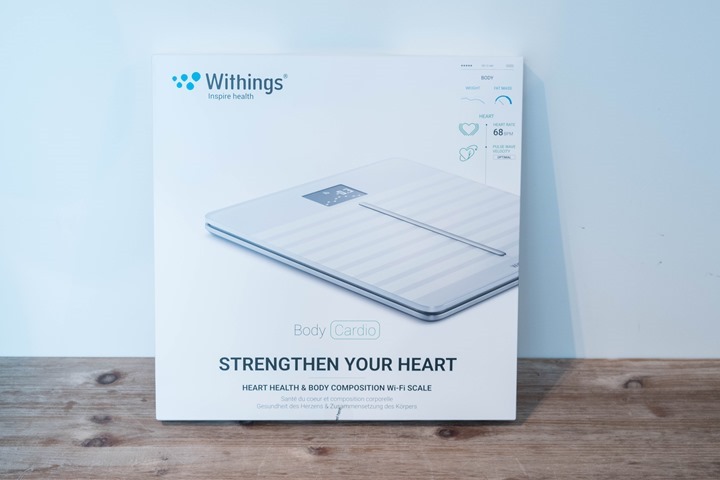
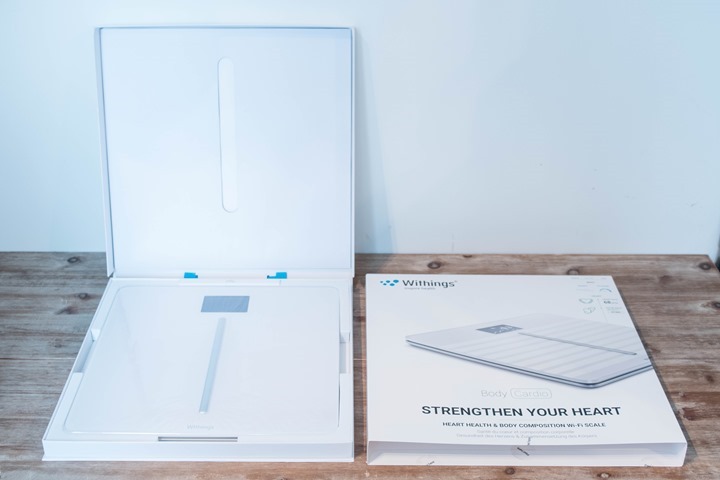
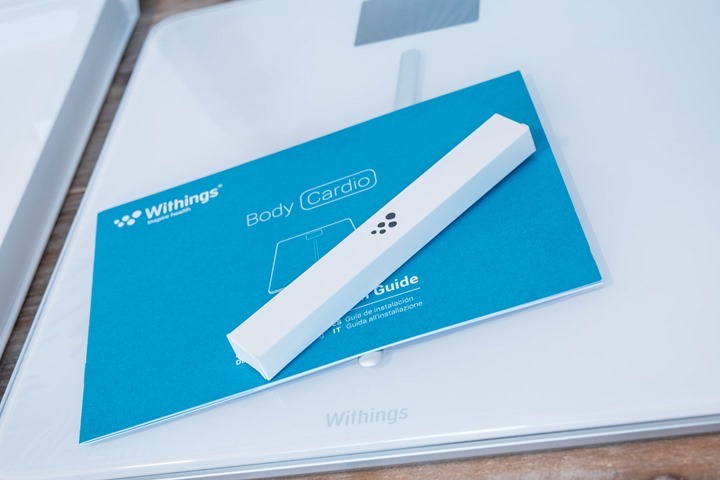
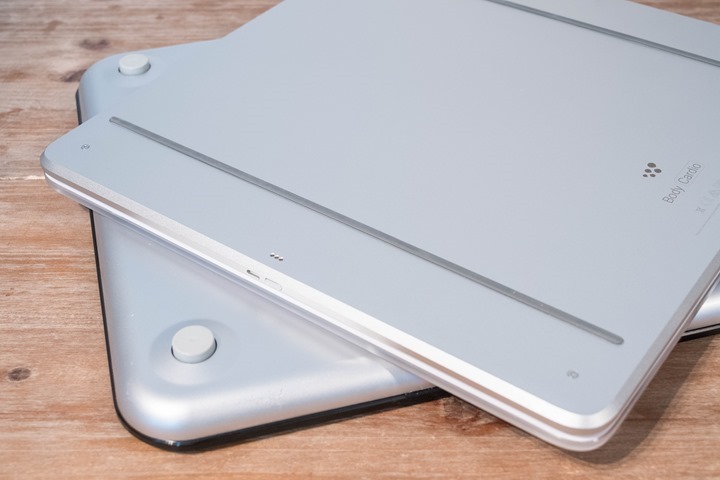
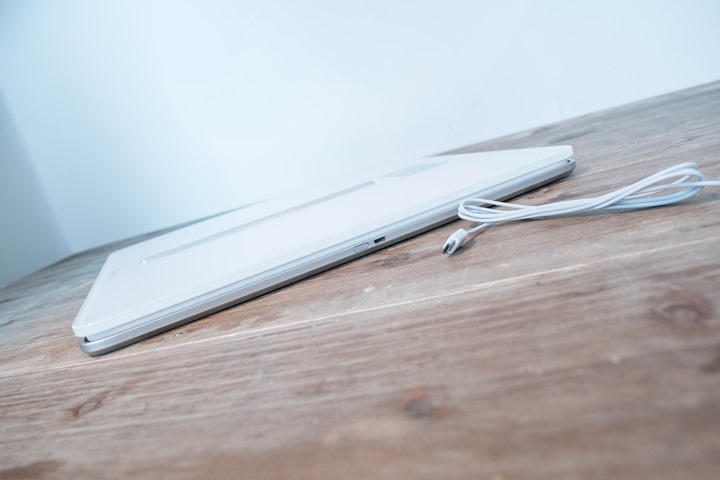
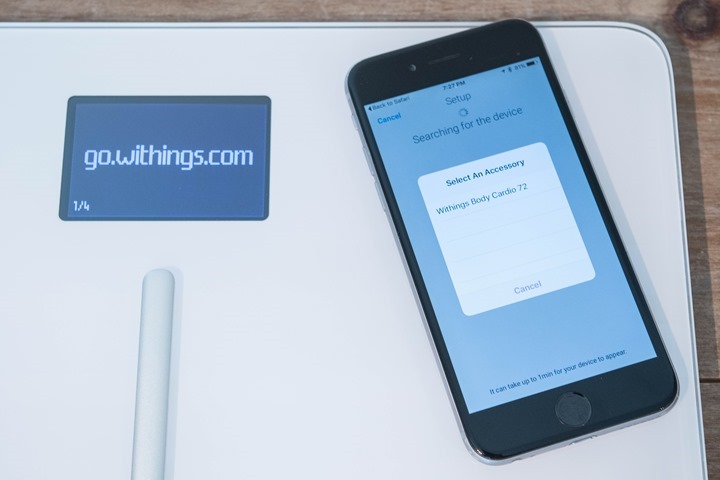
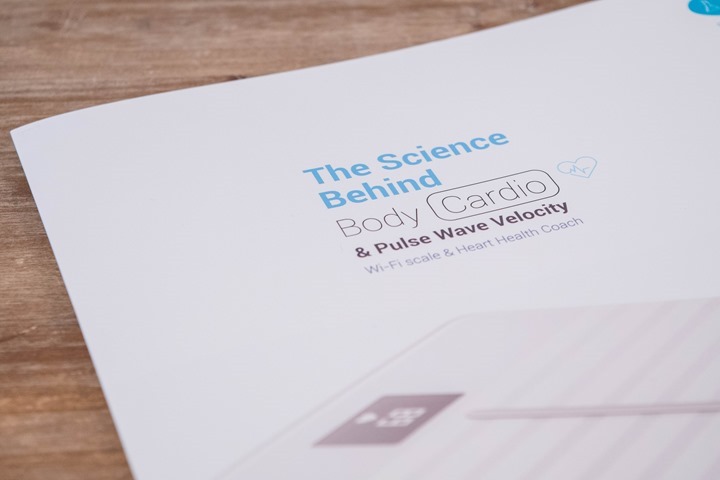
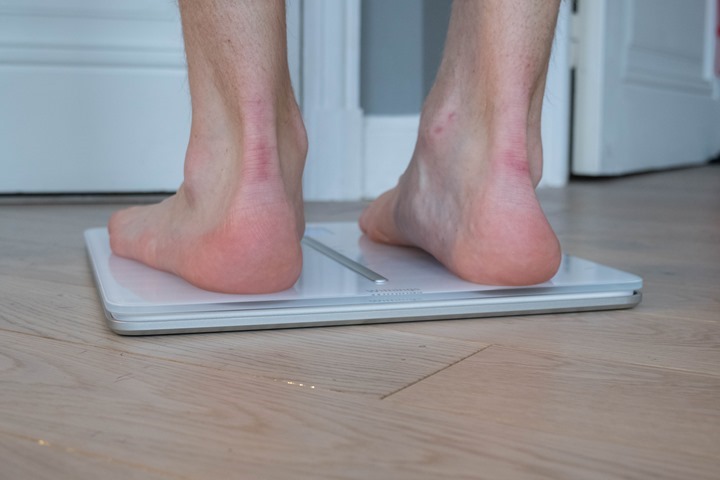
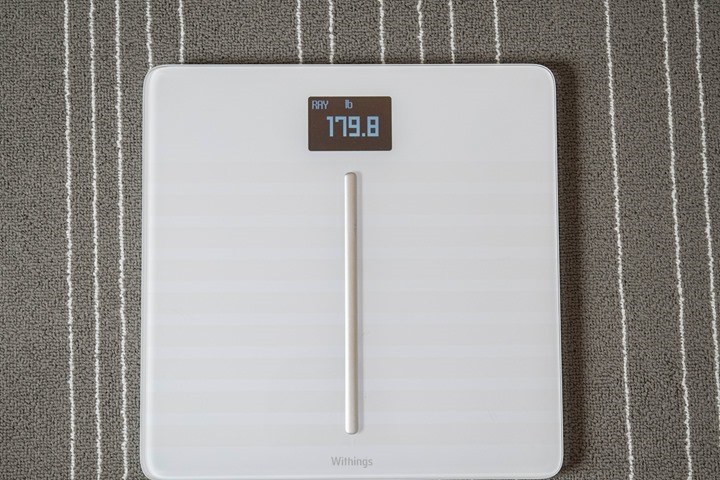
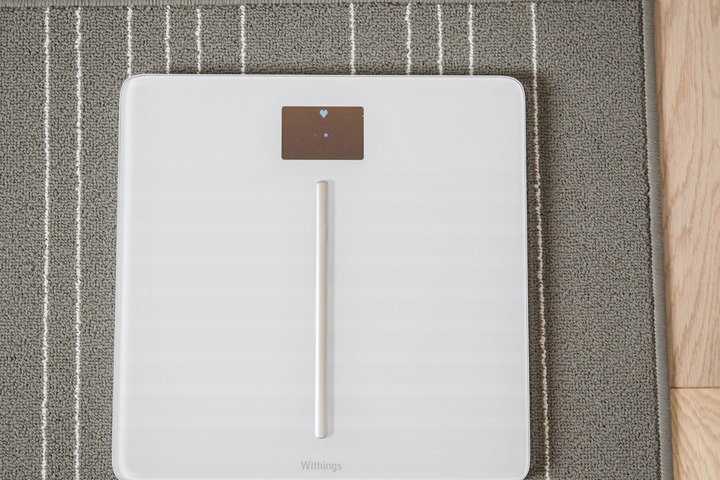
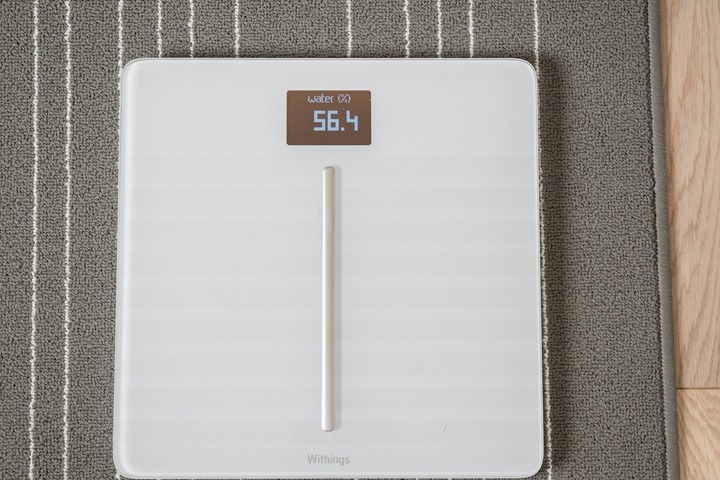

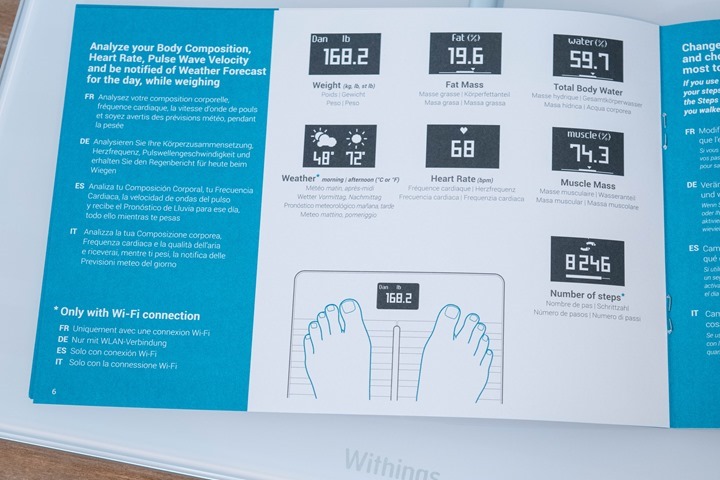


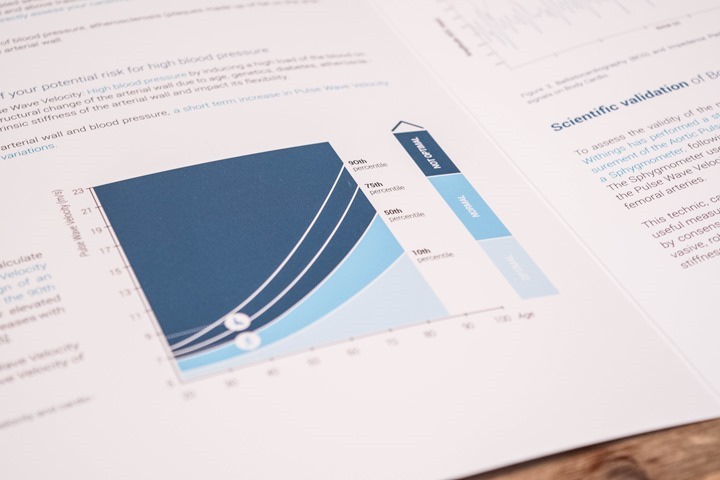

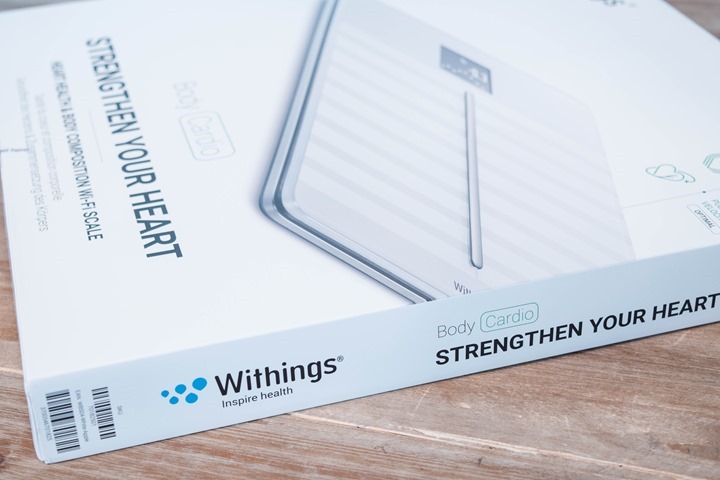





















How’s the girl handling another scale in the house? Haha ?
Hi Ray,
Another nice gadget… useful? maybe
Just 1 comment I’d like to make about body fat measurement. I agree with you that these scales are certainly not super accurate and the values depend on activity on the moment and when you actually weigh yourself.
I’d say people should use it more to see trends in their bodyfat composition (going up or down) and to do that, I personally think you shouldn’t look at values day to day, but more at monthly averages, as there extremes are taken out and you can actually have a pretty good idea about trends in your body composition, at least that’s how I do it with my tanita scale which is still linked to my Garmin profile and it makes pretty much sense.
Sunny (temporarily though) greetings,
Nicky
Hi Ray, I think you have a typo, it’s sphygmomanometer, not sphygmometer.
I knew there was a reason I never made it past the first few rounds of the spelling bee in school!
(Actually, in case you’re curious, I copied the word directly from their study doc. But indeed, Google reveals it’s usually spelled the other way. Changed.)
I can’t believe you spelled that wrong. What a dummy 🙂
looks like an interesting product. i might buy it if it’s possible to get it onto garmin connect or to automatically upload the data to my garmin account in some other way…
Me too, does it sync with Garmin Connect?
Not directly, no.
You can use the MyFitnessPal method to sync base stats, but that’s notoriously finicky. If/when it sync’s my stats for today I’ll see if anything new comes through.
There’s also the little Withings upload site that someone made a while back (sticks content in a .FIT file that you upload to Garmin Connect manually). If that was updated to include the new metrics, it’s possible it might work. Possible being the key item there.
This is the number one frustration i have with all the non-gamin scales – the fact i can’t even manually input a body fat number into connect is immensely frustrating.
Right now i have an Aura, and i would switch in a heartbeat to one of these if it could link properly with garmin.
The index scale is on my list, but garmin doesn’t seem to link it to any of the services my wife uses, only withings and fitbit.
Yeah, definitely a case of Garmin making life more difficult that need be here.
Don’t forget that Withings will also link to an ifttt.com account which also supports Fitbit, Nike+, MisFit, and a multitude of others — and now even better… Strava! —-
There may be a solution somewhere in that combination?
Withings also has a new Body scale that competes directly with the Garmin Index and is priced at $129. Now includes the muscle mass, bone and water metrics as well.
Completely lost faith in the Garmin Index and MyFitnessPal integration as any sync between the two would delete the Garmin Index data in Garmin Connect. This has been an issue since launch in November and has not been corrected.
Will be interesting to see your data on the new Pulse Wave Velocity readings!
Indeed. Just added in a few snippets to help clarify the differences there.
body scale fat measurements might suffer lack of accuracy wide error bars, but I’ve definitely seen value in the relative measurements and trends over periods of weeks -> years. It keeps me *trying* to eat clean anyway! And charts like this are just fun. Like how I seemed to enter some new middle-aged annual sawtooth in 2012, and seemed to fix it in 2015 by doubling my bike commute length. 😉
So are the WS-50 and WS-30 being discontinued? I purchased a WS-50 that is supposed to be delivered today, I’m wondering if I should return it for the Body Scale.
Hi…
i write it 2 weeks before, in a comment that there is a new scale from Withings.. so no surprise for me 😉
i ordered the ws-50… coz the new feature are not important for me and it is all about the software…. so when Withings is willing they can give the new features also to the ws-50 😉
I just did the same thing and before returning it i wanted to see if it was really worth switching from the WS-50 to the “Body”. Although it’s only £10 more for I saw the WS-50 had heart rate monitoring which the “Body” doesn’t.
Did you just say “Taking a dump?” – come on Ray! 🙂
What do *you* do immediately before weighing yourself?
I weight myself before and after, if it’s an especially book worthy porcelain procedure.
I do anything I darn well can to make that number as low as possible.
Wasnt Steve referring to the language? 🙂
Coming soon – the Withings WC50 WiFi Smart Toilet Seat. No time to stand on scales every morning? Well now you can weigh yourself and measure your body composition, all whilst carrying out your normal morning routine. By sending an electrical impulse from one buttock to another, we can bamboozle you with all sorts of data and statistics, most of which are so advanced that even we’re not really sure what they mean. Our patent automatic before-and-after weighing system (please remember to lift feet when you hear the beeps) also gives you another unique data point to add to your online log book.
Best way to lose a pound is to weigh straight after you shower.
That’s only because you pee in the shower
I don’t find the CO2 level on my Withings scale meaningful but it does encourage me to open a window if the level gets too high. I use it more as a “air staleness” metric. So I’d be a little bummed to lose that.
Nothing announced today incentivizes me to upgrade.
I glance at the CO2 levels and never find them interesting, other than one time we had an open house and had people standing around in the bedroom – it really does measure it, it seems!
i have a friend who could use this data to see when his live-in-gf’s migranes triggered – They never managed to predict it ahead of time, but there was almost always a CO2 spike in the days leading up to one hitting – pretty interesting for them.
Actually they are for people who use eg fireplace, Gas heaters and so on.
Looks like the future is just standing on your tablet!
For what it’s worth, I really like the fact that the scale shows me the weather as soon as I step on the scale. Have a WS-50.
Love the Star Wars font. I can hear the opening bars from that piece.
Hopefully, the new ownership will bring some openmindness about platform other than IOS. Especially regarding W10.
So, PWV – is it something that it’s going to be relevant to monitor every day, or is it something that’s only going to change by any noticeable amount over years?
good point here !
and, FYI the correlation graph they show is not the correct statistical way of studying a method versus another. We need a Bland Altman test.
The idea might be good but it looks like a lot of marketing to me…
Hi Ray. Just picked up the Body Cardio scale last night. Set it up this morning. Where on the app/site does it show water %, muscle mass, and bone mass? I’m not seeing any of these additional measurements. It’s essentially giving me weight, body fat %, and heart rate only. Any advice?
Have you updated the app? If you’re using iOS, a new version of Health Mate (2.14.0) that supports the Body Cardio went live on the App Store on Tuesday.
Yup, with the new app you can click on weight, then on the ‘Body Composition’ tab, and then scroll from there.
Thanks guys! I had already updated the App, but apparently under “device settings” you have to enable those extra measurements.
I recently purchased a Withings Body Scale (the latest predecessor of the Withings Body Cardio Scale). I’m a very active person and I take my measurements (weight, body fat percentage (BFP), waist measurement, and blood pressure) every week. For years I had been using an Omron Portable Body Fat Monitor (Model HBF-306) and a conventional digital scale to take my readings. I would manually enter my weight and BFP data into the Apple Health app on my iPhone – so the idea of a smart scale automatically transferring my data Apple Health really appealed to me. Unfortunately, my experience with the scale – and subsequent discoveries regarding BIA devices specifically – forced me to radically change paradigms.
Right from the start, I found that my BFP readings from my Omron hand-held monitor and the Withings Body Scale differed by as much as 2 percentage points. I, of course, was taking these measurements at the same time (first thing in the morning after elimination before any food or water intake). I would take 3 readings and use the average as my entry for the week. Not only did I find that the Body Scale was reporting low, it was also inconsistent – yielding readings from 18.4% to 17% to 20.1%. The Omron was much more consistent, yielding readings of 19.4%, 19.6%, and 19.6%. To verify, I decided to exchange my Body Scale for an identical unit – just to see if my initial unit was a dud. The second scale proved to be slightly more consistent, but still differed by as much as 1%.
This caused me to hop on the Internet and research acceptable margins of error for BIA devices. What I found was eye-opening – and disappointing. The long and short of it is that BIA is an incredibly inaccurate method of computing true body fat percentage. One of the reasons is that these devices only send the electrical current from one hand to the other (via the arms) or one foot to the other (via the legs), depending on what type of device (hand-held or scale) that you’re using. The current totally misses your torso and opposite end of your body, therefore not calculating body fat in those areas. The other limitation of BIA readings is that the devices are incapable of detecting the fat directly beneath the skin. It only can detect the fat that’s inside the body and only the fat that’s in your arms or legs. There were other problems with BIA and a full explanation of the shortcomings can be found in this article:
link to weightology.net
Being a “numbers guy” and an avid data collector, needless to say that this isn’t what I wanted to hear at all. I decided to keep the scale for now because I still like having my weight automatically transferred to Apple Health, and to find another method of tracking body fat (if any). I also stumbled across a “total body” analyzer (hand-held unit & scale combo) from Omron that caught my eye – but taking into consideration the other shortcomings of the BIA method, I’m not sure if it’s worth it. I’ll have to see.
Have any of these smart scales mastered consistent reading of body fat % yet? Meaning that if the scales say “15%” and I use the scale again a few minutes later it still says 15%?
Peter,
Please see the following article:
link to weightology.net
Hi Ray,
how well does it handle uneven floor ? The ceramic in my bathroom isn’t quite perfectly level, tiles are “sticking out” maybe 1 mm, so having feet kind of counters that. Now with the big smooth plate on the scale it might wobble a little bit.
Thanks
Is the water percentage metric worthwhile?
Every morning the scale tells me if I have to pack rain gear for my ride to work. The weather is my favorite feature.
The Garmin Index scale (black only) has been on sale at Amazon for $129.99 for a little while now. I don’t know if it’s a permanent price change but it is at least currently available at the same price as the Withings.
Very nice catch. Now it’s priced rather properly.
Garmin Index is still £125 on amazon.co.uk, I’d have bought one ages ago if it was below the magic £100.
Ray, do you know whether these releases mean we can expect closeout deals on the WS-50? Any tips on where we can find them?
I don’t expect initially, but I expect over time you’ll see sales on them.
Hi Ray,
Can you confirm that if I’m using my Fitbit to record steps, and have my Fitbit account associated with my Withings account, that this will show my current steps (as last synced) on the scale, or is it only from Withings devices?
Hmm, I don’t believe it’ll work.
I don’t think Fitbit pumps into Apple Health at this point (which is what Withings can pull from). And Withings doesn’t have an API for ingest of information into the Withings site (only can pull data out).
I had always hoped the withings temperature reading, Withings would team up with Nest or some other smart thermostat and use the scale as a remote temperature reading source. My bedroom/bathroom/or third floor temperatures can be quite different from the hallway with the Nest thermostat, but it isn’t mobile.
Hello Ray
Will the WBC allow one to take multiple analyst during a 24 hour period? Torn between WBC and Garmin Index but have read comments, reviews that the Index only stores one weighing per day and I want to be able to record multiple results per 24 hour period contingent with my training programs over a day. Will WBC work with Garmin Connect?
On a side note, any suggestions on syncing my Fenix 3HR with the Garmin Connect app. Even with up to date software on the watch, iphone 6, refuses to connect via bluetooth. Thanks?
It’s worth pointing out that Withings have been taken over by the once mighty Nokia.
This is the first product launch following the acquisition and I for one am excited to see what Nokia’s expertise in mobile data and tech will bring to the party.
Look forward to your more thorough write up Ray.
What version of 802.11 do these support? The old scales only support 802.11b. Also, any testing completing setup with Android? I had to borrow an iPhone to get my scale setup last time.
Is the Body as thin as the Body Cardio with the same no-feet design? It looks like that one still takes AAA batteries so maybe it’s not as thin… Assuming there are no major differences between the Body, and the Body Cardio (and assuming you don’t care about heart rate or “pulse wave”) it seems like the Body is a no brainer here…
Not the same feet design. It’s basically just the shell of the existing scales with some minor electronics upgrades inside to keep manuf consistent.
I wasn’t able to wait any longer so I picked up the non-cardio Body. I used to have an old ws-50 so I figure it’s a significant discount with more features than my old one. I don’t think I care about the arterial health stuff. Like heart-rate it seems like the kind of measurement that will fluctuate a lot throughout the day.
Ray,
Any more comments on PWV after having the unit for a while?
Thanks!
…karl
It’s…pulsing? Seems to work well enough overall. No issues with it. I’ll be releasing my review probably in about 2 weeks. I just picked up the non-Cardio version as well, so I’ll be looping both of those in.
That sounds rather ambivalent.
I guess the better question is: Is this implementation of PWV actually useful? Otherwise, it’s a newer WS-50 with built in battery, slightly higher price, and muscle/water % displayed.
Thanks!
…karl
I’ll be honest, I’m not terribly sure yet what to do with PWV. I suspect there’s an element there that makes it more useful if you’re going from being unfit to fit, rather than relatively fit to still relatively fit.
Any further progress with the main review? It’s been more than two weeks 🙂
Got serious gadget eyes with the body cardio scale. But I’d appreciate your comments particularly up against (say) the new Garmin scale.
Should be out Wednesday, unless Tuesday goes to crap, in which case it’ll be out Thursday morning.
I am a 74 year old male who has been a runner for most of my adult life. I don’t do marathons any more, but still run 5 miles most mornings and am thinking about doing a half-marathon this Fall. I’ve been a vegetarian for several years and believe I lead a healthy life style.
Unfortunately, I have a family history of cardiovascular issues, including heart attacks and strokes. Because of this, I have long been monitoring my cardiovascular heath and even though I have no symptoms, I have issues I need to stay on top of. My systolic blood pressure averages 140mm, which falls under the category of Stage 1 hypertension. I had a CT scan last year which showed heavy atherosclerosis, so I am taking a statin to help keep my cholesterol where it should be and prevent more plaque buildup. I am also concerned after reading some studies that showed long distance runners tend to have hardening of the arteries.
I Bought the Body Cardio Scale as soon as it was available due to Withings description of Pulse Wave Velocity as “the only stand-alone measurement that is able to give you the whole picture of your cardiovascular health and your potential risk of having or developing hypertension.” I thought the PWV data would be a good addition to the other things I am doing to monitor my cardiovascular health.
However, I have been getting readings between 7.0 and 7.6, which for my age is “optimal.” Since I know I don’t have an optimal cardiovascular system, I am returning the scale. I can also see where someone who didn’t have a detailed knowledge of their cardiovascular heath could be lulled into a false sense of security if they got similar readings.
I shared my thoughts with my cardiologist and also asked her if it would be worthwhile to have my PWV checked under laboratory conditions to confirm the scale data. Her answer was “Pulse wave velocity is related to arterial stiffness. Affected (as you say) by age, gender and blood pressure. Is a marker for heart disease risk. In view of the fact that we know you have coronary artery disease based on the finding of heavy coronary artery calcification(s) I don’t think that PWV changes our overall risk assessment or treatment plan which consists of aspirin and statin at this time.”
Other issues with the scale is one has to stand almost perfectly still to get a PWV reading and even then it is hit and miss.
Hi BillI guess I am in a similar risk group to you. Age 71, 2 stents 5 years ago, statins and asprin etc. I bought the scale to help me focus on weight loss and BMI. I find that to get good readings I need warm feet – it is winter down here in Australia. I could not get a PWV reading until I soaked my feet in hot water for a few minutes. Poor circulation I guess!
Hi David,
Thanks for commenting. I think we are in the population that would most benefit from meaningful PWV data.
Did your PWV readings correlate with what you already know about your cardiovascular health? Mine didn’t, which is why I took the scale back. IMO, Previous Withings scales do just fine for monitoring weight, body fat%, and BMI.
I had quite a few e-mail exchanges with Withings support regarding my concern about the accuracy of the PWV readings, but the topic quickly was diverted to strategies for getting consistent PWV readings. Mostly doing what is already in the literature – standing still, hands on the wall. Too bad I returned the scale or I would be trying your wet feet solution.
Hi Bill, I did reply a couple of days ago buti t did not appear on the Blog.
I have persevered with my experiment and with dry feet no PWV, but with a warm soak of the feet I always get a result. I appear to have a PWV of 7.0 – unlikely! It will be interesting to see how this develops over time.
I agree, testing 111 people in a hospital with no additional patient information hardly constitutes a valid test of PWV. I would like to suggest a bit of crowd science here. As the user base expands Withings could ask users to collaborate and share their metrics and basic medical details. Over time some realistic statistics may emerge?
I think the issue with the PWV is that it appears to be population dependent. Withings in their paper use 111 patients… With no other information.
If you dig into PWV devices, it is a bit of a unknown quantity currently. We know that it correlates well with increased arterial resistance is patients KNOWN to have cardiovascular disease or it’s risk factors already. But there doesn’t appear to be any correlation in young fit individuals. Which for a lot of people would make the reading of little use, if not potentially worrying.
I have analysed a couple of journal articles about PWV and put a break down in relation to the Withings Body Cardio here:
link to titaniumgeek.com
As Withings doesn’t give their raw data in the paper it immediately makes the paper suspect. My FEELING is that 111 patients they tested the device on, at a hospital, who have a correlation with a r coefficient of 0.7 (strong association) MAY have been patients with known heart disease and risk factors, hence getting nice data to support their PWV product.
Hence why the device says a 32 y/o medic, with good blood pressure, and a 20:09 5KM BP may have non-optimal PWV (there is no correlation of significant with PWV in young for people and increased arterial stiffness)
Lean
Da
I just sold my old ws-50 after using it for a year and a half. I know the fat percentages might not be totally accurate, but it is a good indicator.
Now i have the new Body Cardio. I love the new look, but it givea me some strange measurements.
I get a fat percent of around 16 % which is the same as the old ws-50. But the muscle mass is around 80% and bone mass is 4%. It all adds up. But what about organs? Water is around 55.
And i it is the correct measurements, why even buy the new weight, since I could just use the fat percentage. Maybe i just misunderstood something, but i cant find any info on this from Withings. Maybe somebody here can enlighten me? 🙂
I have been very impressed with my Body Cardio so far. I weigh myself as soon as I get up (after a pee) and the weight and body fat seem very consistent and for that reason have motivated me to reduce the weight and body fat a little (it all helps the power to weight ratio). Whilst the PWV is a new factor it does follow my BP, training and general stress levels well. You might ask what is the point? Like a lot of fit middle aged people I have always thought of myself as indistructable, I can do all of this activity, hold down a stressful job and balance family and other life commitments. But an alternative daily reality check on how your body is really feeling is a useful addition to all of my training data which for me is all about beating my body up and less about how my body is feeling.
Just my thoughts and I really look forward to Ray’s views!
Agree that the PWV data is interesting when considering the correlation with blood pressure, stress etc. It certainly seems to leap about after a night on the vino.
Looks like Withings has some supply issues, as this is still only available via Apple.
I asked Withings about this, and got a guess of maybe September/October for availability in other retailers.
Heard anything else Ray?
…karl
Apple exclusivity ended July 1st. I believe Clever Training got in Body Cardio units this past Monday (and shipped them all out), and are now operating on a 5-7 day backorder. Which basically means their next shipment is sometime next week.
Given that I’m still not seeing it on Amazon and many other retailers, and Clever Training (which being in Canada makes them less attractive than apple.ca) shows availability as “pre/order”, makes me think that Withings still has a supply issue or is just trying to delay general release to clear out remaining WS-50 inventory (which has dropped to $130 CAD from $200).
Makes we wonder if this scale is worth 50% more than a WS-50.
…karl
Units came in and went out, but Withings has far more demand than they expected. It sounds like backorder will be the name of the game for a while oddly enough. :-/
I had the first surprise with Body Cardio when I had to pay 30$ shipping fee when I received it, despite the fact that it clearly says “Free shipping” for my country on their web site. After I went through the setup of the App, I received data from the scale for three days, then the data wouldn’t get updated anymore. I went through the Wifi setup again, then it worked again for two days. So far I had to run setup for about fife times now. The App doesn’t show if it is connected or not so there is no way of telling if it can receive data or not. I contacted their support about the connectivity problems but never got a reply. All together a bad user experience.
I have the same problem with my Body Cardio. But i also had it with my old WS-50 scale.
As a test i have placed the scale closer to my WIFI, but i might also give it a try with changing the WIFI channel to another frequency.
Im a bit dissapointet that the new scale only supports the WIFI G standard.
I was curious if the scale is consistent with measurements. I have found my Fitbit Aria can give different readings almost every time you step on it.
Brendan
I’d really appreciate if you could add a mention of how accurate each scale is on carpet to your comparison chart.
From what I can tell, a number of the WiFi scales come with feet for this purpose, but they’re not sufficient for anything but the thinnest carpets. This seems to be the first that works well on carpet out of the box, but I really don’t need the other extra features that drive up the price.
Hi Ray
The start of this review promises a full, in depth review later this summer…
Did I miss that?
Being offered one at 40% off so seriously considering upgrading from my existing withings scale.
Hi Giles-
Yup, it’s right here: link to dcrainmaker.com
Though good point – I forgot to add a pointer in this point. Doing that now.
Cheers.
Thanks Ray, sorry I hadn’t seen that.
Only 2 complaints.
1. Weight precision is not very good, but long term doesn’t really matter.
2. With Cardio and iPhone7 Plus the bluetooth never works after setup regardless if I reset and start over. All I want to is change screens displayed, but connection is never completed. So, the screen order will never update.
Hi, just received my Withings Body Cardio. I installed it with the app but the muscle percentage never appeared with my measurement, neither in the app. The quick installation guide also says that it should display my steps, but nothing appeared. How do I turn that feature on?
I have the scale and I don’t get a HR or reading about 80% of the time, I contacted support and they say I have to have damp feet, does anyone else experience this.
Having to wet your feet before weighing to me is crazy, I think my scale is defective.
DC, did you experience this or has anyone else have problems ?
I feel like this scale is 100% not worth it.